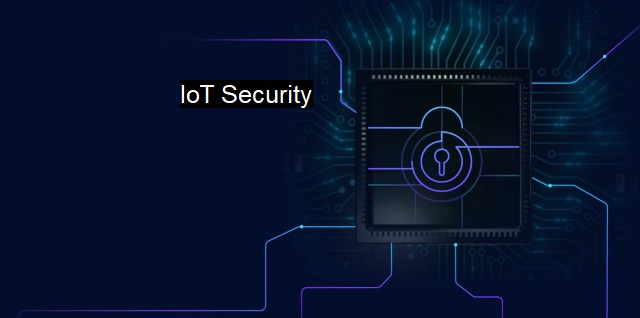What is IoT Security?
IoT Security: Mitigating Cyber Threats and Protecting Privacy in the Growing World of Connected Devices
Internet of Things (IoT) refers to a complex web of interconnected devices that extends beyond standard devices like computers and smartphones to include objects like smart home devices, wearables, and smart city technologies — all of which communicate with each other and share data. IoT security, therefore, concerns all safeguarding measures that are implemented to protect these interconnected devices and the networks they form from cyber threats.Why is IoT Security Necessary?
It's important to understand the nature and context of IoT to appreciate the necessity of IoT security. Traditional devices such as computers and smartphones tend to have security features and protecting them from cyber threats is typically straightforward. IoT devices, on the other hand, are not always designed with security in mind, making them potential targets for cybercriminals. They can be exploited to gain unauthorized access to networks, steal data, conduct surveillance, create a denial of service scenario or even carry out physical attacks.
The sheer number of IoT devices poses a critical challenge. It is estimated that approximately 50 billion IoT devices will be in use globally by 2030. The widespread adoption of IoT across different sectors, such as transportation, energy, healthcare, and smart homes, drastically expands the attack surface for potential cyber threats.
IoT devices often lack rigorous regulation and standards, leading to inconsistent security practices. IoT security steps in to ensure the integrity of these devices and the safety of the data they exchange. Both cybersecurity and IoT security share the same essential objective: safeguarding data and systems from malicious actors.
Risk Categories in IoT Security
Many categories of risks exist in the sphere of IoT security. These include physical risks, network risks, software risks, and risks linked to human error or behavior.
Physical risks can emerge when an unauthorized person gains direct physical access to an IoT device. Network risks arise when communication between IoT devices is intercepted or when an attempt is made to penetrate network security. Software risks concern the potential vulnerabilities that might exist with the device's software. Lastly, risks associated with human behavior often come into play, as flawed configuration or mishandling of the device and its data can result in security breaches.
Elements of Antivirus and IoT Security
Antivirus software plays a key role in IoT Security. It can guard IoT devices against intrusion and help detect and remove malicious software. some IoT devices have limited processing capabilities, which makes it challenging to equip them with traditional antivirus measures. Therefore, security strategies need to evolve to effectively counter the threat landscape.
For most IoT devices, the solution lies in realizing a multi-layered security approach, where safeguards are implemented at various levels of the system: device layer, network layer, and the cloud or data center layer. This approach allows for securities like encryption, secure boot, and regular updates at the device level, where most common antivirus products cannot penetrate.
Conclusion
IoT Security represents one of the most significant challenges in the field of cybersecurity. The existing multitude of connected devices with heterogeneous capabilities and myriad potential vulnerabilities necessitates robust security solutions. IoT security focuses on protecting not just individual devices, but the entire interconnected system from the ever-evolving threat landscape. The integration of antivirus alongside the multi-layered security approach is vital to maintain the integrity of devices and ensuring the safety of system data.

IoT Security FAQs
What is IoT security?
IoT security refers to the practice of ensuring the protection of internet of things (IoT) devices and networks from cyber threats and vulnerabilities. It involves implementing various measures, such as authentication, access control, encryption, and regular updates, to ensure the confidentiality, integrity, and availability of IoT systems.What are some common IoT security risks?
Some common IoT security risks include vulnerable or obsolete software, weak or default passwords, unsecured communication channels, and lack of firmware updates. Other risks include denial-of-service attacks, data breaches, and physical tampering.What are some best practices for IoT security?
Some best practices for IoT security include using strong and unique passwords, regularly updating software and firmware, implementing two-factor authentication, segregating IoT networks from other networks, and regularly testing and scanning IoT devices for vulnerabilities. It is also crucial to have a comprehensive cybersecurity plan and incident response plan in place.How can antivirus software help with IoT security?
Antivirus software can help with IoT security by detecting and blocking malware and other threats that may compromise IoT systems. Some antivirus software also provides additional features, such as vulnerability scanning and system optimization, that can enhance the security and performance of IoT devices. It is important to ensure that any antivirus software used is compatible with the specific IoT devices and systems being used.| | A | | | B | | | C | | | D | | | E | | | F | | | G | | | H | | | I | | | J | | | K | | | L | | | M | |
| | N | | | O | | | P | | | Q | | | R | | | S | | | T | | | U | | | V | | | W | | | X | | | Y | | | Z | |
| | 1 | | | 2 | | | 3 | | | 4 | | | 7 | | | 8 | | |||||||